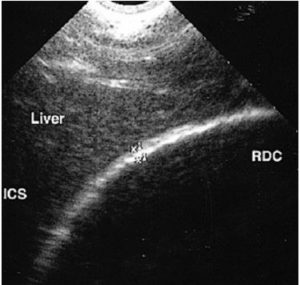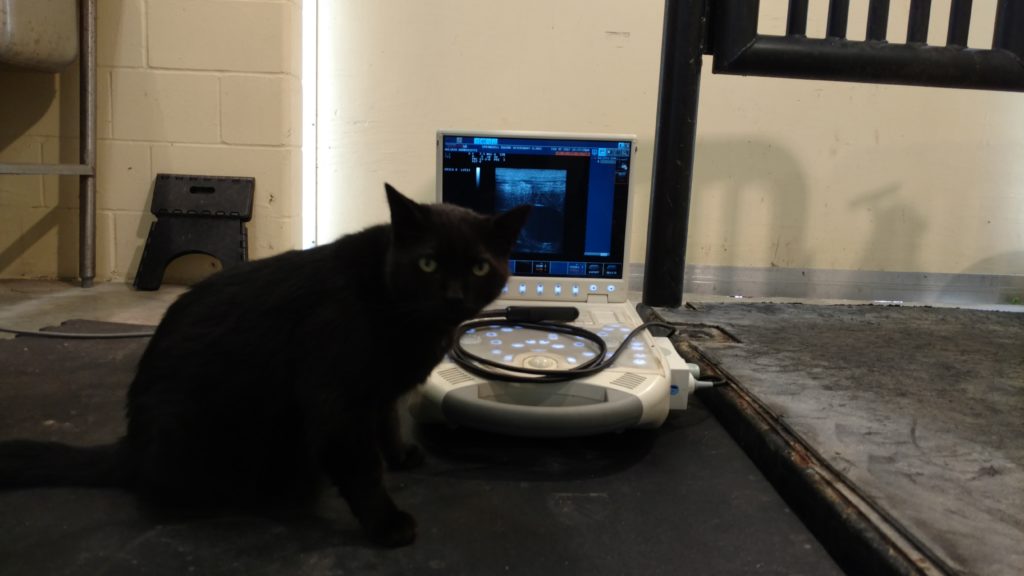
Tuesdays with Tony – The Imaging Edition
I closely supervised the Docs this week in the Clinic, and I noticed two significant pieces of equipment being used on a regular basis: the ultrasound and x-ray. Being a curious cat, I sat them down and asked why x-ray this horse but not that one? Which led to: when do you use the ultrasound? Read on for some profound learning from a very wise cat.
Ultrasound
Both ultrasound and x-ray use waves of energy to make a pretty picture, kind of like a camera. The ultrasound uses, wait for it, sound waves. Sound waves go into the body and bounce off different tissues before coming back to the probe. The computer inside the ultrasound then turns the waves into an image. Lots of things affect the waves, but the biggie is how much water is in the tissue. This means things like muscles and babies make really pretty images because they are mostly water.
Tendons and ligaments can be easily seen too. While they don’t contain as much water as muscles, they are very tightly organized and surrounded by other tissues which do contain water (mostly, see more later). When tendons and ligaments do get injured, they dramatically increase the water (edema) in the area of an injury making injuries very easy to see (again, mostly, you’re going to have to keep reading).
What are ultrasounds bad at seeing through? Air, think lungs and gas filled guts, and hard stuff like bone and hooves. The Docs can still use the ultrasound to get an idea about the contours of lungs and bones. In fact, it’s one of the easiest ways to tell if a horse has pneumonia. Ultrasound is also a first line tool used to check for some bone fractures. The ultrasound can’t see through air though so only the very outside edge of the lungs can be checked. That air (well gas really) is very useful in the GI tract. In the image below our Docs used the gas/tissue interface to determine if this horse had the potential for hind gut ulcers.
The next place that would be really nice to see with the ultrasound is inside the hoof. There are some really important things in there that would be great to see with an ultrasound. Unfortunately, the hoof capsule is great at bouncing those sound waves. In a pinch, the hoof can be soaked for about 24 hours, then the outermost layer of sole pared down with a hoof knife, and the ultrasound very, very firmly held against the frog. This is a very limited viewing window, but can be useful to recheck after an MRI.
Another place sound waves like to be difficult is the back of the hock. In this area lives a very important structure called the proximal suspensory ligament. This ligament is a source of many curse words here at Springhill Equine. The ligament is between the splint bones, under some blood vessels, and right next to the cannon bone. To top it off it contains muscle and ligaments in a twisted, woven bundle. Sound waves bounce around like crazy which drives the computer inside the ultrasound machine crazy. The computer does it’s best to sort it all out, but often it fills in the blanks a little wrong, causing what’s known as an artifact. Moral of the story here is that imaging proximal suspensories is hard, and imaging is only part of the picture. Yes, that’s a pun, and I’m pretty proud of it!
X-ray
Moving on to x-rays. Technically, radiology. X-rays are the waves that are used to make a radiograph, just like visible light is the wave used to make a picture. OK, technical stuff covered. All those things ultrasounds hate, x-rays love. Radiographs are the best option for anything bone, or air filled (again there’s an exception, and I’m going to make you read the entire blog to find out what it is). X-rays shoot straight through bone and air to make a picture on a plate placed on the other side.
Radiographs are very much like the pictures you shoot with your camera. Think of the x-ray machine as the sun and the plate as your camera, with the subject of the picture being your horse. Radiographs are great at seeing changes in bone like arthritis, and changes in density. Radiographs are also great at looking at the whole structure of the lungs, instead of just the surface that ultrasounds see. And x-rays go right through that pesky hoof capsule to let us see the bones inside. What they can’t see are soft tissues. And this means it’s very often a team effort between radiographs and ultrasound to get a complete image of the inside of your horse.
I’m not making you read to the very end for the x-ray exception, only mostly to the end. Horses are big. They are nearly as big as I think I am. This is a problem for radiographs and ultrasound. Neither of these waves are strong enough to push through the big ol’ butt on a horse. From about where the back of a saddle sits to the start of the tail, horses are solid muscle, bone, and hay filled gut. This combination is able to scatter all the x-rays that hit before they can reach the plate and absorb all the sound waves so that deep ones can’t get back to the computer.
We can get some hints about what’s going on in there, but getting a clear picture is like trying to figure out what it looks like at the bottom of the Marianna’s Trench in the Pacific Ocean: it ain’t easy. Make stronger waves you say. Sadly, physics says no. If you make the wave stronger it can’t go as deep, if you make it weaker it can’t reach the other side. There is no easy answer here. A good physical exam, watching your horse do what it does, and then evaluating the problem are the best answer for low back pain and high hind end lameness in horses. Luckily I know a couple of awesome veterinarians with a ton of horse sense to back up their medical knowledge 😉
Until next week,
Tony


